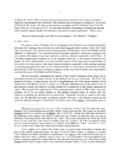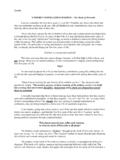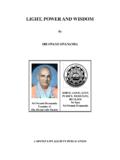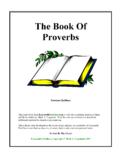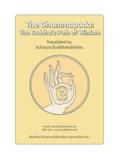Transcription of THE IMPRINT OF THE BEZELS OF THE WISDOM - Ibn Arabi
1 Page 1 IBN ' Arabi 'S OWN SUMMARY OF THE FUS S "THE IMPRINT OF THE BEZELS OF THE WISDOM " WILLIAM C. CHITTICK William C. Chittick, 1975 and 1976. This translation first appeared in Sophia Perennis (Tehran) Vol. 1, No. 2 (Autumn 1975) and Vol. 2, No. 1 (Spring 1976). It was reprinted in the Journal of the Muhyiddin Ibn ' Arabi Society Vol. 1, 1982. It may not be reproduced without the permission of the Ibn ' Arabi Society. Introduction THE importance of Ibn 'Arab for Islamic intellectual history is well-known. His school determines the course of most metaphysical speculation within Sufism from the 7th/13th century onward, and in addition it profoundly influences later Islamic philosophy, especially in The importance of Ibn 'Arab 's Fus s al-hikam (usually translated as the " BEZELS of WISDOM ")
2 As the quintessence of his writings and thought and a major source of his influence is also well-known,2 and is attested to by the more than one hundred commentaries written upon Ibn 'Arab is also the author of a work called Naqsh al-fus s (the " IMPRINT " or "Pattern of the Fus s"), in which he summarizes briefly the main discussions of the Fus s itself. Because of the importance of the Fus s the Naqsh al-fus s also takes upon a special importance, and for this reason it has been commented by a number of well-known figures of the school of Ibn 'Arab , including Sadr al-D n Qunyaw and 'Abd al-Rahman J m.
3 4 J m 's work, Naqd al-nus s fi sharh naqsh al-fus s, written in the year 863/1459 is particularly famous in the East. This is indicated by a number of facts, 1 On the influence of lbn 'Arab in Sufism, philosophy and elsewhere, see Nasr, "Seventh-Century Sufism and the School of Ibn 'Arab ", Sufi Essays, London, 1972, 2 See Nasr, Three Muslim Sages, Cambridge (Mass.), 1964, 3 See O. Yahya. Histoire et classification de I'oeuvre d'lbn ' Arabi , Damas, 1964 pp. 241-255; also the same author's Arabic introduction to Amoli, Le texte des textes, Tehran-Paris 1975, pp 16-33.
4 4 Yahya lists ten commentaries on this work in Le texte des textes, See also Histoire et classification, Yahya mentions in the latter work, , that Naqsh al-fus s has also been attributed to Isma' l ibn Sawdak n al-N r , a disciple of lbn 'Arab . But the fact that Qunyaw , Ibn 'Arab 's foremost disciple and according to most accounts his stepson, wrote a commentary upon it as a work of his own master would seem to be sufficient proof of its authenticity. This commentary, one manuscript of which is mentioned by Yahya as existing in Damascus, also exists according to Sayyid Jal l al-D n shtiy n , in a private collection in Mashhad.
5 Page 2 including the large number of manuscripts of it which exist in various The title of this book, whose text is two-thirds Arabic and one-third Persian, means "Selected Texts in Commenting the Naqsh al-Fus s", and indeed one of the most interesting points of the work is the large number of quotations gathered from various Sufi authors, which J m has chosen with both metaphysical and mystical insight and literary taste. In the introduction to Naqd al-nus s, J m writes as follows: "These are a few words gleaned from the texts of the spiritual elite which comment upon the meaning of the Naqsh al-fus s, which Ibn 'Arab.
6 Abridged from and dedicated to the principles and essential elements of the Fus s al-hikam, which is the seal of his writings .. (The present work is) like the patch-work cloak of the Sufis, each patch acquired from a different place and sewn to the others with the thread of appropriate-ness and the tie of harmony .. Some (of these texts) are the blessed words of the magnanimous Shaykh (Ibn 'Arab ) himself, and some are the sacred sciences exposited by his followers, among the great Masters: such as .. Sadr al-D n Muhammad ibn Ishaq al-Qunyaw and his disciples and beneficiaries, including the perfect gnostic, Mu'ayyid al-D n al-Jand , who is the first commentator of the Fus s al-hikam, and Shaykh Sa'd al-D n Sa' d al-Fargh n , who is the commentator of the Poem of the Way of Ibn F rid; and others.
7 Especially the commentators of the Fus s al-hikam". The three names mentioned in the above passage are of particular importance, for they signify that in J m 's mind the most important figures in the school of Ibn 'Arab are, after the Magister Maximus (al-Shaykh al-Akbar) himself, first Sadr al-D n Qunyaw (d. 673/1274-5) and then his disciples, Jand and Fargh n . The fact that Qunyaw is the most important expositor of the doctrines of Ibn 'Arab in the eastern lands of Islam has indeed been recognized,6 although it is remarkable that, as far as the present writer knows, no study of him has been made in Western The reason that an intellectual figure of his magnitude who should be considered second only to his master in the exposition of theoretical gnosis ('irf n-i nazar )
8 In Islam could have gone so completely ignored8 can only be his proximity to Ibn 'Arab , so 5 Yahya mentions twenty in Le texte des textes, but I was able to find about fifty in the famous catalogues and another 25 in the Solaymaniyyah Library in Istanbul and by no means can I claim to have done a thorough job of searching. It has also been printed in lithographed editions at least three times in India and Iran. 6 See Nasr, Sufi Essays, 7 I am in the process of editing and translating his Tabsirat al-mubtadi', a Persian work which introduces the reader to Ibn 'Arab 's metaphysical universe, but with remarkable simplicity and basing itself almost exclusively on the Quran and Hadith.
9 8 Even in the East it is only scholars like the great contemporary hak m Sayyid Jal l al-D n shtiy n who are fully aware of his importance. See shtiy n 's Sharh muqaddima-yi Qaysari bar Fus s al-hikam, Mashhad, 1385/1966, , footnote. The only work of Qunyaw which has been published in a modern edition is I'j z al-bay n, 2nd edition, Hyderabad-Deccan, 1368/1949; also printed in Cairo as al-Tafs r al-s f lil-Qur' n, 1389/1969. shtiyan is in the midst of printing his Nus s. At least Page 3 that like the moon he has been effaced by the sun.
10 In any case there is no doubt that all of the followers of Ibn 'Arab 's school in the East see their master through Qunyaw 's eyes or the eyes of his immediate disciples. The disciples and students mentioned by J m only two of dozens of important figures, including such men as Fakhr al-D n 'Ir q and Qutb al-D n Sh r z are also of prime importance in Ibn 'Arab 's school and deserve serious J m goes so far as to say that all of the commentaries upon the Fus s go back to that of Jand ,10 and a study of two of the most famous of these, by Qaysar and K sh n.
